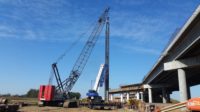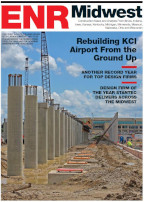Akey reconstruction of a major route in Kansas City is wrapping up this month, featuring a dramatic cable-stayed bridge. The Missouri Dept. of Transportation credits design-build, which it rarely has used, with slashing years off the $245-million “Interstate Connections” (kcICON) project. It was originally slated to finish next July and will be within its $245-million budget.

Construction began in April 2008 on the project to widen and reconstruct the 4.7-mile-long Paseo Corridor that carries Interstate 29/35 from North Kansas City into the northeastern corner of Kansas City’s downtown freeway loop. The stretch handles 102,000 vehicles per day.
In addition to the new $90-million Christopher S. Bond Bridge over the Missouri River, the design-build team widened the corridor from four to six lanes, built or rebuilt ramps and flyovers, and reconfigured or rebuilt several interchanges under its $232-million contract.
Paseo Corridor Constructors comprises a joint venture of Clarkson Construction Co. and Massman Construction Co., both of Kansas City, and Kiewit Construction, Omaha, Neb. Parsons Transportation Group’s Chicago office and TranSystems Corp., Kansas City., served as designers.
“The flexibility of the design-build approach gave the contractor and designer the ability to rephase work and make hundreds of little changes that continuously made the project more efficient,” says Brian Kidwell, MODOT project director. MODOT is now considering design-build delivery on future projects. Paseo Constructors spokeswoman Laura Wagner says representatives from other state DOTs have visited the project.
The 1,700-ft-long bridge is named for Christopher S. “Kit” Bond, a former Missouri governor who is now completing his fourth term as a U.S. senator. It has a 124-ft-wide deck that now carries seven driving lanes and in the future could carry an eighth lane plus a pedestrian/bicycle walkway. It replaces the 56-year-old four-lane Paseo Bridge, which had only two lanes in each direction. Demolition of the old bridge will be complete by spring.
A single delta-shaped cast-in-place concrete support pylon rises 316 ft above its foundation in the river. Forty cables measuring up to 16 in. in diameter connect the pylon to the bridge’s 550-ft front span and 451-ft back span. The spans feature a steel-girder support structure that is topped by precast-concrete deck panels as well as a cast-in-place concrete driving surface.
For better efficiency, steel sections of the support structure, made up of two edge girders and three floor beams, were pre-assembled on shore and barged to the construction site, where they were lifted into place by barge-mounted cranes.













